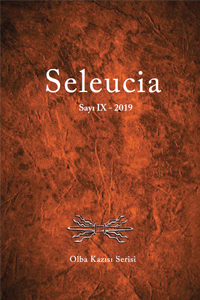Hellenistic and Early Roman Imperial Glass Finds from the Acropolis of Olba
Archaeological excavations carried out at the acropolis of Olba provided important evidence on the settlement history of the site from the Late Chalcolithic – Early Bronze Age onwards. Roman rule and the process of “Romanization” started in the region - including Olba - after Pompey’s victory over the Cilician pirates in the Eastern Mediterranean. Olba which was already a residential center in the Hellenistic period, transformed into a Roman town during the process of “Romanization” in the region. Excavations on the eastern slope of the acropolis in AZ 5 – AZ 14 trenches yielded glass finds dating back to the Hellenistic period until the end of the seventh century when Olba was abandoned. In this study the Hellenistic and Early Imperial Roman glass from the acropolis of Olba will be presented and evaluated. While Hellenistic glass finds from the acropolis reveal the presence of typical forms for the time; Roman Imperial glass vessels and objects have characteristics found throughout the entire Roman world. In addition to the mass-produced, regular free-blown table wares, highly sophisticated products from Early Imperial times were discovered during the excavations of Olba. Th us, it should be concluded that Olba was more than a provincial hilltop settlement center, but rather a typical Roman town demanding luxury goods for an exclusive life style.
Hellenistic and Early Roman Imperial Glass Finds from the Acropolis of Olba
Archaeological excavations carried out at the acropolis of Olba provided important evidence on the settlement history of the site from the Late Chalcolithic – Early Bronze Age onwards. Roman rule and the process of “Romanization” started in the region - including Olba - after Pompey’s victory over the Cilician pirates in the Eastern Mediterranean. Olba which was already a residential center in the Hellenistic period, transformed into a Roman town during the process of “Romanization” in the region. Excavations on the eastern slope of the acropolis in AZ 5 – AZ 14 trenches yielded glass finds dating back to the Hellenistic period until the end of the seventh century when Olba was abandoned. In this study the Hellenistic and Early Imperial Roman glass from the acropolis of Olba will be presented and evaluated. While Hellenistic glass finds from the acropolis reveal the presence of typical forms for the time; Roman Imperial glass vessels and objects have characteristics found throughout the entire Roman world. In addition to the mass-produced, regular free-blown table wares, highly sophisticated products from Early Imperial times were discovered during the excavations of Olba. Th us, it should be concluded that Olba was more than a provincial hilltop settlement center, but rather a typical Roman town demanding luxury goods for an exclusive life style.
___
- Aksoy 2019
Aksoy, F., Olba akropolisi Sikke Buluntuları, Ankara Hacı Bayram Veli Üniversitesi,
Lisansüstü Eğitim Enstitüsü, Arkeoloji Anabilim Dalı’na sunulan yayınlanmamış Yüksek
Lisans Tezi, Ankara.
Antonaras 2012
Antonaras, A., Fire and Sand – Ancient Glass in the Princeton University Art Museum,
New Haven.
Charlesworth 1966
Charlesworth, D., “Roman Square Bottles”, Journal of Glass Studies, VIII, 26-40.
